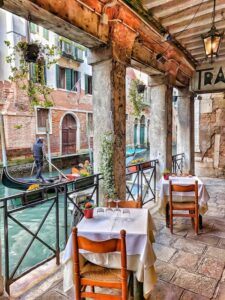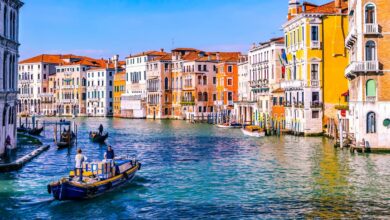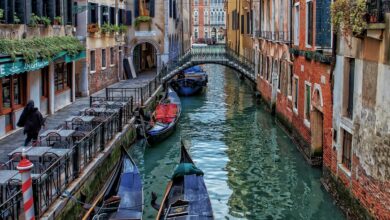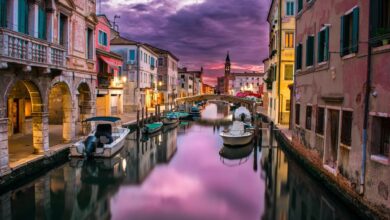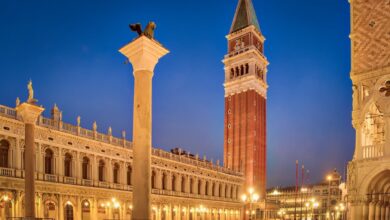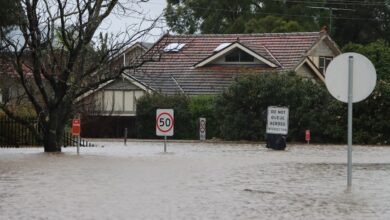Venice (The Beautiful Sinking City)
Venice is easy to fall in love with. It’s one of the world’s most beautiful cities. There’s no denying why tourists from all over the world flock here in droves, thanks to its pristine architectural heritage, stunning stretch of the Grand Canal, and unrivalled romantic feelings. Venice is one of Italy’s most well-known cities. However, there are few sites that can be compared to Venice.
The city has a wonderful renaissance air about it, which is most likely due to the city’s centuries-old, unaltered architecture. When you visit Venice, you feel as if you are entering a work of art, a masterpiece. The city’s network of islands, canals, pedestrian alleys, and bridges could keep any traveler occupied for hours. It’s chock-full of stunning sights, art galleries, museums, and eateries. Plus, it has a charm that no other European city can match. While it has suffered from over tourism in recent years, there are still options to explore at your leisure by avoiding peak season and visiting during the off-season.
Table of Contents
ToggleTourism in Venice
One of Venice’s most important industries is tourism. Despite the fact that many residents believe tourists are a nuisance, they cannot overlook the truth that tourism is critical to the city’s survival. Annually, an estimated 20 million tourists visit Venice, and the number continues to rise with each passing year.
The city attracts visitors because of its fascinating history and architecture. A tourist tax, often known as a visitor charge, has been introduced to assist fund critical restoration work. Regardless, Venice is on its way to becoming more of a living museum than a true city. Venetians are continuing to flee the area as tourism drains the city’s vitality.
The city of Venice in Italy is practically sinking.
Venice is Sinking
It has always been flooded by acqua alta (very high tides), but the frequency of these events has grown in recent years. Residents are kept informed of the expected intensity of the floods through a flood warning system that includes siren alerts and text notifications. People wear wellington boots and stroll on raised pathways, but structures aren’t that fortunate.
The water levels have risen to the point where they are permanently above the original damp proof courses of the city’s oldest homes and buildings. The friable clay bricks are attacked by saltwater, which causes them to disintegrate and allow in more water. As a result, many of Venice’s buildings’ ground floors are now unusable. Underwater barriers have been installed to decrease the amount of water entering the lagoon in order to protect them and prevent further erosion. More than 18 years after its development began, the system became fully operational in the summer of 2021.
Facts about Venice
You may believe you already know everything there is to know about Venice. The distinctive gondolas, the raucous carnival, and the beautiful bridges that cross the canals are all well-known.
However, beneath the surface of this fascinating city, there are many secrets to be discovered. Whether you’re planning a vacation to Venice soon or simply want to learn more about this popular city, it’s time to learn some fascinating facts about Venice!
Venice is made up of 118 Islands
The city of Venice is actually made up of several islands, each with its own personality and landmarks. These islands, hidden in a tranquil coastal lagoon, are connected by 400 bridges and 170 waterways, giving Venice its particular appeal. It’s easy to forget they’re different islands as you stroll about because the land mass feels like that of a single metropolis.
The city and its islands are now a UNESCO World Heritage Site and one of Europe’s most famous tourist sites.
Venice’s Grand Canal
Venice’s Grand Canal is two and a half miles long. Because there are no cars in Venice, the Grand Canal carries 60% of all city traffic, making it one of Italy’s most vital waterways. Despite the fact that it is busy, it lacks the intensity of driving down a congested highway.
Venice is Built on Some Pretty Special Logs
The majority of Venice’s gorgeous buildings are built on petrified wooden platforms (fossilized and mineral-rich logs) that serve as the city’s submerged foundations. These logs are constructed from alder trees, which are noted for their water resistance, and were initially imported from central European nations such as Slovenia and Croatia.
Venice is Renowned for Glass Blowing
Venetians have been making glass since the 10th century, and their processes have resulted in some of the world’s best glassware. Murano glass is the name given to Venetian glass when all of the city’s glass-making workshops were relocated to the nearby island of Murano in 1291.
The glass industry relocated due to concerns that the hot furnaces used in glass making could cause a fire hazard to Venice’s mostly wooden structures. Take a day trip from Venice to Murano if you have the opportunity. It’s incredible to witness this age-old technique in action.
